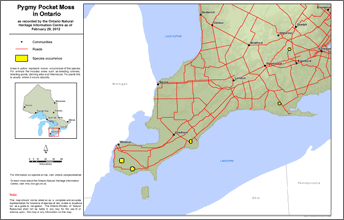Pygmy pocket moss
Scientific name: Fissidens exilis

Status
Special Concern
“Special Concern” means the species lives in the wild in Ontario, is not endangered or threatened, but may become threatened or endangered due to a combination of biological characteristics and identified threats.
Date added to the Species at Risk in Ontario List
The Pygmy pocket moss was already assessed as a species of special concern when the Endangered Species Act took effect in 2008.
What it looks like
The family to which the Pygmy pocket moss belongs is named for its leaves. The lower part of the inner side of a pocket moss leaf is doubled, producing two overlapping blades that form a pocket. Pygmy pocket moss leaves are only one to two millimetres long at most. The entire plant stands no more than two millimetres high, except for the pale to reddish reproductive stalk and spore-containing capsule that grows to a maximum height of about three to 10 millimetres. The overall colour of the moss is dark green to dark brown.
Where it lives
The preferred habitat for Pygmy pocket moss is moist, bare, clay soil often associated with seepage areas and river banks. It usually grows in woodlands, and sometimes on soil that has been disturbed by human activity.
Where it’s been found in Ontario
Although widespread in Europe, Pygmy pocket moss has limited distribution in North America. The first discovery of Pygmy pocket moss in North America was made in 1947, in Cleveland, Ohio, and since then it has been observed in 16 American states. In Canada, a few populations have been documented in southern Ontario and Quebec. In Ontario, this includes Essex County, the Municipality of Chatham-Kent, Norfolk County, and the Regional Municipality of Waterloo. There have been a few confirmed records in Quebec, from Gatineau Park near the Ontario-Quebec border, the west end of Montreal Island and Quebec City (St. Foy).
View a larger version of this map (PDF)
What threatens it
The factors affecting the limited distribution of Pygmy pocket moss in Canada are uncertain. Southern Ontario and Quebec may represent the northern limit of its distribution in North America, so climate might play a role, although European populations are found much further north. Specific micro-habitat conditions may be limiting its distribution, but it is not known what conditions, if any, are factors.
Action we are taking
Special concern species do not receive species or habitat protection.
What you can do
Report a sighting
- Report a sighting of an endangered animal or plant to the Natural Heritage Information Centre. Photographs with specific locations or mapping coordinates are always helpful.
Volunteer
Volunteer with your local nature club or provincial park to participate in surveys or stewardship work focused on species at risk.
Be a good steward
Private land owners have a very important role to play in species recovery. You may be eligible for stewardship programs that support the protection and recovery of species at risk and their habitats.
Report illegal activity
Report any illegal activity related to plants and wildlife to 1-877-TIPS-MNR (847-7667).
Quick facts
- mosses do not flower and they reproduce by microscopic spores rather than seeds
- Pygmy pocket moss can self-fertilize and produce fertile spores without being in close proximity to other Pygmy pocket mosses
